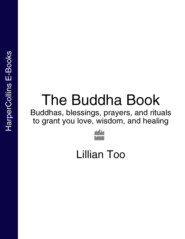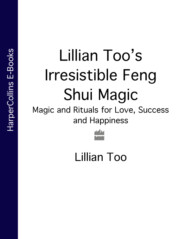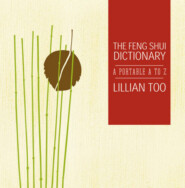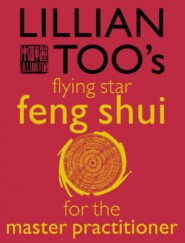По всем вопросам обращайтесь на: info@litportal.ru
(©) 2003-2024.
✖
Lillian Too’s Smart Feng Shui For The Home: 188 brilliant ways to work with what you’ve got
Автор
Год написания книги
2019
Настройки чтения
Размер шрифта
Высота строк
Поля
Take compass directions inside the main door and again a few feet further inside.
Take a third compass direction from the center of your home. If your home is an irregular shape, mark in missing areas on your floor plan and draw diagonal lines (as shown) to find its center.
12 – understanding the lo shu square
The next step in practical feng shui is to familiarize yourself with one of the most important, and effective, feng shui symbols that can be used on your floor plan.
This is the Lo Shu Square, which is a ninesector grid, each containing a number from 1 to 9. The numbers are arranged in the grid so that when any three numbers are added, they add up to 15, which is also the number of days it takes the moon to grow from a new moon to a full moon, and vice versa. The Chinese Taoist scholars regard the Lo Shu as a magic square and believe that it provides the key to unlocking many of the secrets of feng shui’s other important symbol, the eight-sided Pa Kua (see here (#u7acab31b-10f6-4639-a329-cea041724ef5) and here (#u4d3fc4c1-a854-45bb-9cc2-7a4e389e949f).)
According to legend, the magical Lo Shu Square of numbers was carried on the back of the celestial tortoise and brought to the attention of the Chinese Emperor, Fu Hsi. So today, the tortoise is revered as an auspicious creature whose body and shell are said to conceal special design motifs that contain all the secrets contained in heaven and earth.
I started writing books about feng shui soon after I picked up the shell of a dead turtle that had been washed up on the shore on a seaside vacation trip to Pangkor Island with my family. That was in 1992. At that time I failed to note the significance of that omen, and although I brought the shell back home, I discarded it soon afterwards. I only realized the symbolism while one day meditating by my pond where my pet terrapins lived (terrapins are domestic tortoises and turtles are the marine relations of the freshwater tortoise.) It was while I observed the patterns on the back of these playful creatures that the significance of that symbolic find struck me.
Later, as you go deeper into your practice of feng shui, you will discover how important and clever the Lo Shu Square of numbers is when it comes to both hiding and revealing the secrets of formula and compass feng shui. For now, just familiarize yourself with the Lo Shu Square, its numbers and directions, and how it can be used to demarcate the layout of your floor plan.
13 – placing the lo shu square over a floor plan
Now you have learnt the basics about the importance of the Lo Shu Square, you can experiment with placing it over your home’s floor plan.
While this is easy enough to do if the layout of your home is a perfect square, unfortunately this is seldom the case – most homes do have an irregular layout.
Modern homes are rarely, if ever, perfectly square or rectangular. In hallways or in the rooms there will be missing corners and protruding corners, and sometimes the shapes are so irregular that even the real chi that enters gets confused by the flow which is created by the unusual shape of the home.
You also need to know whether to include or exclude portions of the home that appear to protrude. Also, what about including areas occupied by garages, patios, decks, or verandas? In view of the great many variations of house plans and shapes, superimposing the nine-sector grid is therefore something of a challenge to those unfamiliar with feng shui applications. Here are a few specific guidelines that I have put together, based on my experience and advice given to me by practicing feng shui masters.
To superimpose the Lo Shu Square over an irregular-shaped home, extend the missing areas on your floor plan. When you overlay the square you will see which area of it you are missing. Here, the southwest is missing, which is associated with love and relationships.
Lo Shu lore
For interiors in both houses and apartments, the Lo Shu Square should be superimposed onto all the built-up areas that share a roof mass. This means that for apartments you should first superimpose the Square onto the whole building, then apply it to the apartment space itself. This will give a much more accurate assessment of the apartment’s feng shui and its suitability for a resident.
When there is more than one level, each level should be treated separately, since different floors usually have different areas and dimensions.
When the floor space is irregular, some masters superimpose two different Lo Shu Squares. Personally, I prefer to use one grid and treat areas that are empty as missing corners.
When a floor plan is narrow and deep or broad and shallow, some masters look at the way the rooms in the home have been arranged and use a six-grid Lo Shu instead of the traditional nine-grid Lo Shu. This means dropping the center grids. I prefer to continue using the nine-grid Lo Shu, with the demarcated sectors equally worked out in terms of floor area. Therefore, in effect, the Lo Shu Square can be stretched vertically or horizontally.
Superimposing the Lo Shu onto a floor plan is the most practical method of demarcating sectors within the home. This enables the practitioner to identify the different corners for purposes of applying the different formulas, and also energize the corner according to the Elements that are allocated to each of the sectors. In short, superimposing the grid enables you to start understanding the energy of your space and take action to enhance it.
For regular floor plans, the Lo Shu Square should fit proportionally over the available space. Here, the rectangular shape of the individual squares reflects the overall shape of the floor plan.
14 – understanding the two pa kuas
The Pa Kua is an eight-sided symbol which signifies many of the secrets of feng shui. It is a special tool that is a central part of feng shui practice. It can be used for assessment or protection.
Each of the eight sides of the Pa Kua has several associations, including a direction, an element, a member of the family, and an organ.
Most significantly, on each side of the Pa Kua is one of the eight root trigrams of the I Ching. How these trigrams are placed around the different sides of the Pa Kua determines what kind of Pa Kua it is. There are two arrangements to these trigrams and therefore there are two kinds of Pa Kua: the Yin Pa Kua and the Yang Pa Kua.
The Yin Pa Kua
Here the trigrams are arranged in what is described as a cyclical pattern, where the trigrams are arranged as pairs of opposites. This arrangement is generally referred to as the Early Heaven Arrangement of trigrams. The most important trigram, Ch’ien, which represents heaven and the patriarch, is placed in the south and directly opposite in the north is the trigram that represents the matriarch, the trigram K’un. These two are the ultimate yang and yin trigrams respectively. So there is nothing more yang than Ch’ien, and there is nothing more yin than K’un. The arrangement of the trigrams in the Yin Pa Kua is said to possess intrinsic power that can control shar chi, or killing energy. Thus this is the arrangement that is placed round the Pa Kua used for deflecting the poison arrows of straight roads, T-junctions, and other harmful structures. The Yin Pa Kua is essentially a remedy tool in feng shui practice.
It should never be displayed or hung anywhere inside the home. It should not be used to counter poison arrows that are present inside the home. In destroying the shar chi of the poison arrow, it will also harm residents who inadvertently get hit by the Pa Kua. I stress this very strenuously as I am aware of people masquerading as feng shui masters who sell Pa Kua mirrors and recommend they be hung inside the home. Please don’t do this, as it is very dangerous.
The Yin Pa Kua’sarrangement of trigrams create protective yin energy when placed outside the home.
15 – understanding the yang pa kua
This is the diagnostic Pa Kua that is used to analyze the feng shui and chi flow of all the rooms contained in homes and offices.
The arrangement of the trigrams in this Pa Kua is the Later Heaven Arrangement, and here they reflect the premise that the relationship between the opposites of the Early Heaven Arrangement has given way to changes. The philosophy behind this Pa Kua is the inevitability of change. So now the trigram that is placed in the south is no longer Ch’ien but is instead the trigram Li, and the trigram in the north is no longer K’un, but Kan. The ultimate yang and yin trigrams are now placed in the northwest and southwest respectively.
Placement of the trigrams
It is when you spend a little time taking note of the arrangement of trigrams and their placement around this Yang Pa Kua that you begin to really understand the fundamental basis of feng shui practice. For now it is sufficient to know that we use the Yang Pa Kua for analysis for our feng shui practice, and not the Yin Pa Kua, which is more suitable for yin dwellings, or graveyards. So to practice feng shui, learn the attributes of each of the sides of the Yang Pa Kua.
The Pa Kua contains six rings that give different information to the feng shui practitioner (see here (#u2b472503-fd77-470a-976f-ff5fad9ed0bf)) One ring gives the life aspiration, for example career prospects or recognition and fame; the second the compass direction; the third the color of the Element; the fourth the Element, such as Water or Fire; the fifth the trigram; and the sixth the trigram character itself.
The Yang Pa Kuais the one that is used in feng shui analysis. The difference between this and the Yin Pa Kua is the way the trigrams have been placed. The arrangement of trigrams here is known as the Later Heaven Arrangement. This reflects the essence of yang feng shui. It reflects the cyclical nature of energy and shows how this can be activated to create and accumulate quantities of precious yang energy. It is this yang energy that brings life, activity, success, and joyousness to living spaces. In advanced feng shui work, both the Pa Kuas are combined to analyze the landforms around the home.
16 – how to use the yang pa kua in feng shui practice
Now we come to the first and easiest way to practice feng shui. The Pa Kua has many different rings with varying attributes to enhance your home.
I call this the Eight Aspirations of Mankind method as signified by the eight root trigrams of the I Ching that are placed around the eight-sided Pa Kua. Note that each side represents one direction. So as there are eight sides, all the eight directions of the compass around a central point are accounted for.
From the preceding pages we have already learned how to take directions and how to identify the different directions and sectors of the home. Now we will need to analyze the Yang Pa Kua in order to transfer the attributes of each of the eight sides of the Pa Kua onto your home and to do this in such a way that the quality of the chi in each sector of your home is enhanced with preliminary, but extremely fundamental, feng shui techniques.
First study the many layers of meanings associated with each of the eight different sides of the Yang Pa Kua shown here. Note that every direction sector contains different attributes that offer clues to how that part of any living space can be activated, energized, and enhanced. The energy of each sector also has a yin or a yang aspect and every sector is representative of the Element energy assigned to that sector under this arrangement of the trigrams. In the following pages the practical implications of each of the layers shown in the Pa Kua will be explained. Later, when we learn to go deeper and start to use the formulas of feng shui, the attributes of the directions as shown in the Pa Kua will take on even deeper and greater significance, so do spend some time studying these attributes.
From the Yang Pa Kua may be derived many rings of characteristics and element symbolism that give meaning to compass sectors.
17 – assess the pa kua sectors separately
Each home sector should be carefully assessed to see if there are imbalances in the energy there that should be corrected using the attributes of the Pa Kua.
Using the Pa Kua highlights the effects of missing and protruding corners, which can be good or bad depending on how they impact on the personalized feng shui of residents. Detailed examination of the sectors also shows the effect of shapes, colors, and room usage on the overall luck of the family.
Here the way you assess the sectors depends on whether you use the Lo Shu method or the Pie Chart method. The space covered under the two methods differs quite considerably. If you examine the two methods used on the floor plans below, you will see how the rooms and corners of rooms deemed to fall into different directions of the compass sectors differ quite considerably. If you are unsure which method to use you might want to follow my example and do away with the Pie Chart method completely. I have always used the Lo Shu Square method to demarcate rooms as I find this to be the most practical.
In addition, readers may be interested to know that the Lo Shu numbers actually make up the base upon which many of the most powerful formulas of feng shui are formulated. Secondly, since most rooms of most houses are either square or rectangular, using the grid method is much easier from a practical viewpoint. Some of you may find that certain rooms fall into two, or even three, different sectors. In such cases, the conventional wisdom to which many feng shui masters of repute subscribe is to follow the attributes indicated by the largest floor area covered.
1. The entrance is in the north sector.2. The living room is in the east and northeast, which protrudes so the east and northeast are emphasized.3. Bedrooms are in the southeast and southwest.4. Bathrooms and toilets are in the south.5. The dining room is in the west
18 – the eight directions and the five elements
Probably the most significant thing to commit to memory regarding the eight directions is the element that is associated with each of the directions.










